Blockchain Technology: Society's Perception and Adoption Purpose
VerifiedAdded on 2022/09/12
|12
|2595
|23
Report
AI Summary
This report provides a comprehensive overview of blockchain technology, encompassing its characteristics, creation, and diverse applications, including retail loyalty programs, data sharing, and payment processing. It critically evaluates the benefits of blockchain, such as enhanced transparency, security, and cost reduction, while also addressing its limitations, including excessive energy consumption, scalability issues, and potential for misuse. The report further examines how society perceives blockchain and the purposes driving its adoption, as well as the expected norms of behavior from its participants. Furthermore, the report delves into the theoretical underpinnings of blockchain technology, exploring relevant theories such as ontology, epistemology, and axiology, thereby providing a multifaceted understanding of its implications and significance. This assignment is an analysis of the technology and its impact on business and society, and is contributed by a student to be published on Desklib, a platform that provides AI-based study tools for students.
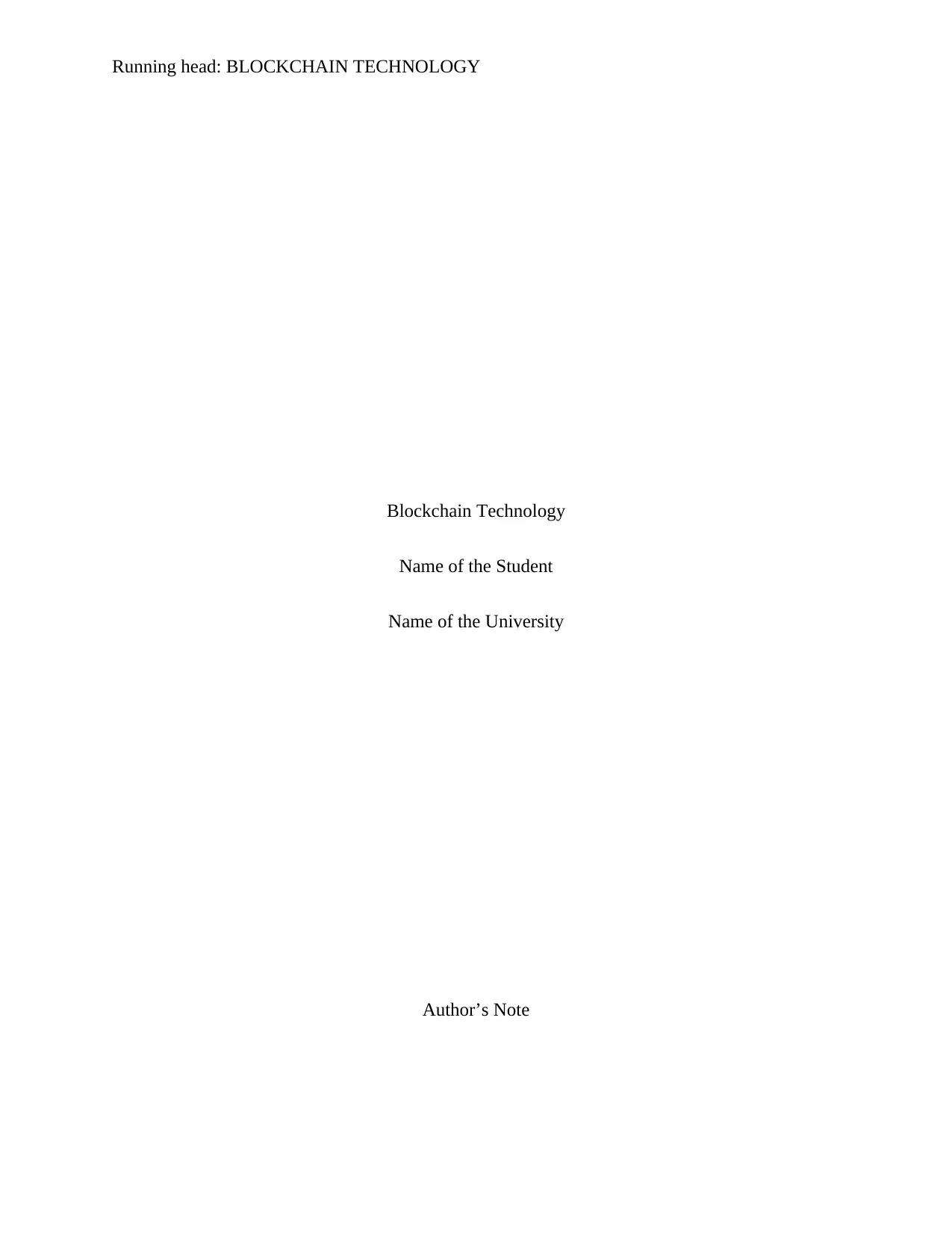
Running head: BLOCKCHAIN TECHNOLOGY
Blockchain Technology
Name of the Student
Name of the University
Author’s Note
Blockchain Technology
Name of the Student
Name of the University
Author’s Note
Paraphrase This Document
Need a fresh take? Get an instant paraphrase of this document with our AI Paraphraser
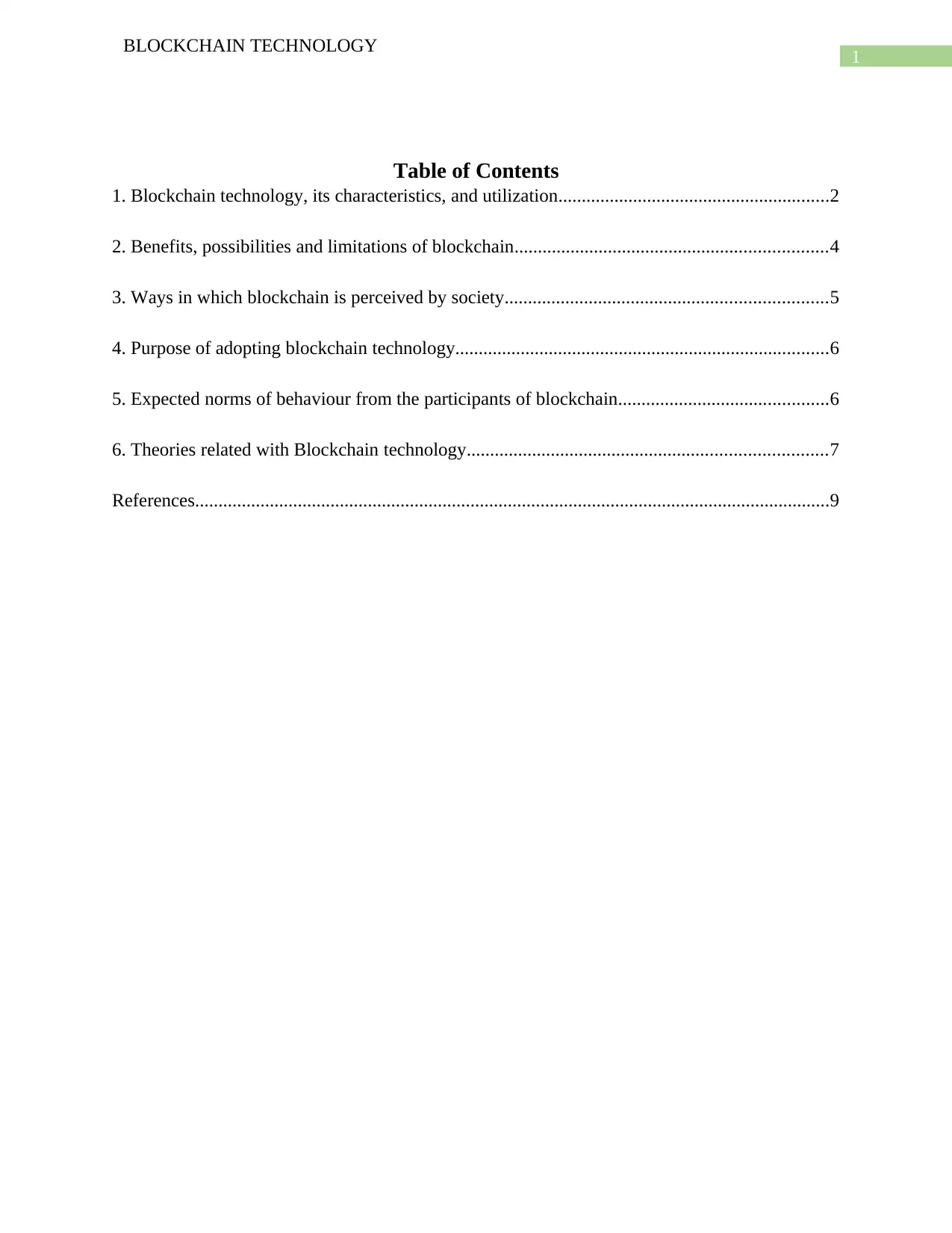
1
BLOCKCHAIN TECHNOLOGY
Table of Contents
1. Blockchain technology, its characteristics, and utilization..........................................................2
2. Benefits, possibilities and limitations of blockchain...................................................................4
3. Ways in which blockchain is perceived by society.....................................................................5
4. Purpose of adopting blockchain technology................................................................................6
5. Expected norms of behaviour from the participants of blockchain.............................................6
6. Theories related with Blockchain technology.............................................................................7
References........................................................................................................................................9
BLOCKCHAIN TECHNOLOGY
Table of Contents
1. Blockchain technology, its characteristics, and utilization..........................................................2
2. Benefits, possibilities and limitations of blockchain...................................................................4
3. Ways in which blockchain is perceived by society.....................................................................5
4. Purpose of adopting blockchain technology................................................................................6
5. Expected norms of behaviour from the participants of blockchain.............................................6
6. Theories related with Blockchain technology.............................................................................7
References........................................................................................................................................9
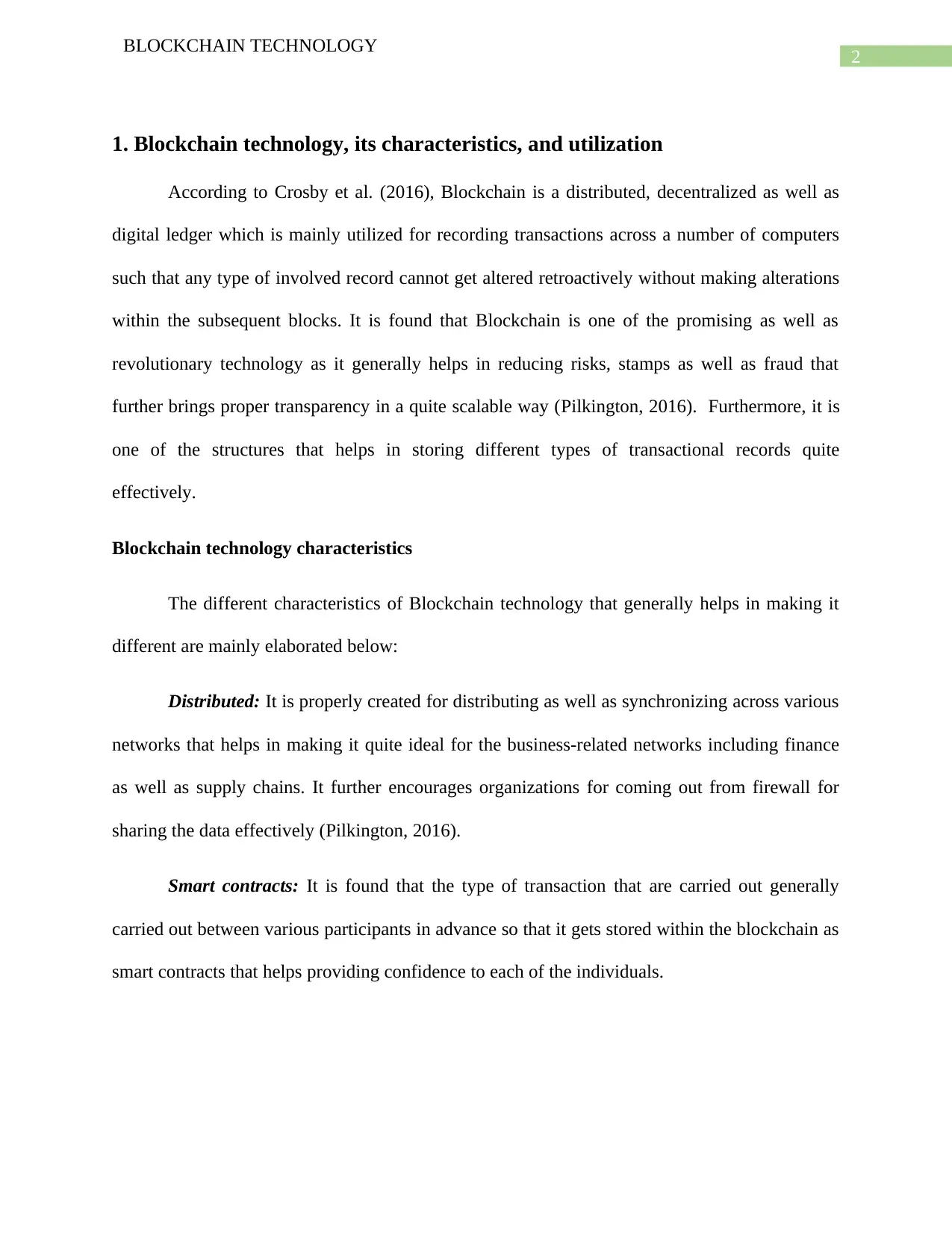
2
BLOCKCHAIN TECHNOLOGY
1. Blockchain technology, its characteristics, and utilization
According to Crosby et al. (2016), Blockchain is a distributed, decentralized as well as
digital ledger which is mainly utilized for recording transactions across a number of computers
such that any type of involved record cannot get altered retroactively without making alterations
within the subsequent blocks. It is found that Blockchain is one of the promising as well as
revolutionary technology as it generally helps in reducing risks, stamps as well as fraud that
further brings proper transparency in a quite scalable way (Pilkington, 2016). Furthermore, it is
one of the structures that helps in storing different types of transactional records quite
effectively.
Blockchain technology characteristics
The different characteristics of Blockchain technology that generally helps in making it
different are mainly elaborated below:
Distributed: It is properly created for distributing as well as synchronizing across various
networks that helps in making it quite ideal for the business-related networks including finance
as well as supply chains. It further encourages organizations for coming out from firewall for
sharing the data effectively (Pilkington, 2016).
Smart contracts: It is found that the type of transaction that are carried out generally
carried out between various participants in advance so that it gets stored within the blockchain as
smart contracts that helps providing confidence to each of the individuals.
BLOCKCHAIN TECHNOLOGY
1. Blockchain technology, its characteristics, and utilization
According to Crosby et al. (2016), Blockchain is a distributed, decentralized as well as
digital ledger which is mainly utilized for recording transactions across a number of computers
such that any type of involved record cannot get altered retroactively without making alterations
within the subsequent blocks. It is found that Blockchain is one of the promising as well as
revolutionary technology as it generally helps in reducing risks, stamps as well as fraud that
further brings proper transparency in a quite scalable way (Pilkington, 2016). Furthermore, it is
one of the structures that helps in storing different types of transactional records quite
effectively.
Blockchain technology characteristics
The different characteristics of Blockchain technology that generally helps in making it
different are mainly elaborated below:
Distributed: It is properly created for distributing as well as synchronizing across various
networks that helps in making it quite ideal for the business-related networks including finance
as well as supply chains. It further encourages organizations for coming out from firewall for
sharing the data effectively (Pilkington, 2016).
Smart contracts: It is found that the type of transaction that are carried out generally
carried out between various participants in advance so that it gets stored within the blockchain as
smart contracts that helps providing confidence to each of the individuals.
⊘ This is a preview!⊘
Do you want full access?
Subscribe today to unlock all pages.

Trusted by 1+ million students worldwide
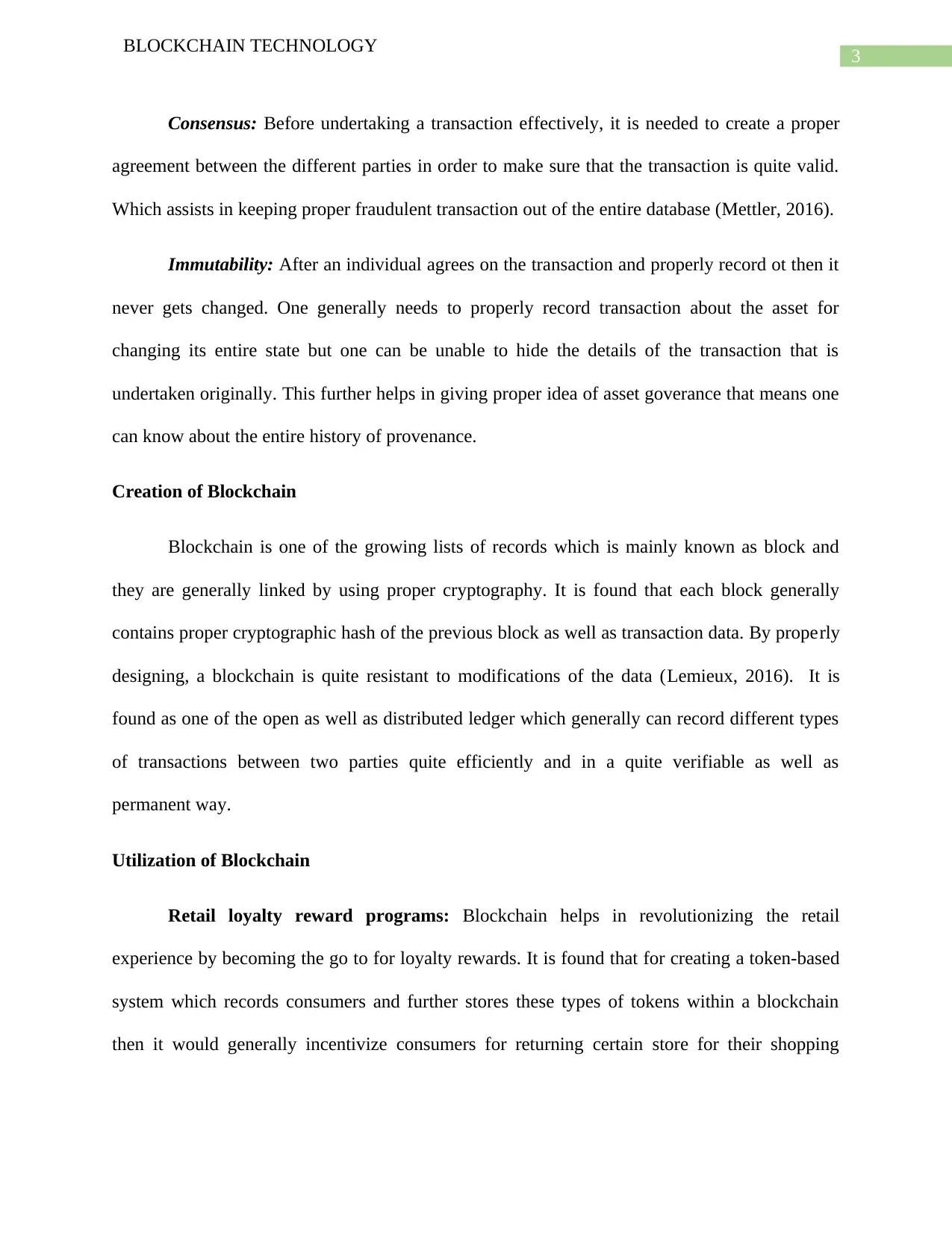
3
BLOCKCHAIN TECHNOLOGY
Consensus: Before undertaking a transaction effectively, it is needed to create a proper
agreement between the different parties in order to make sure that the transaction is quite valid.
Which assists in keeping proper fraudulent transaction out of the entire database (Mettler, 2016).
Immutability: After an individual agrees on the transaction and properly record ot then it
never gets changed. One generally needs to properly record transaction about the asset for
changing its entire state but one can be unable to hide the details of the transaction that is
undertaken originally. This further helps in giving proper idea of asset goverance that means one
can know about the entire history of provenance.
Creation of Blockchain
Blockchain is one of the growing lists of records which is mainly known as block and
they are generally linked by using proper cryptography. It is found that each block generally
contains proper cryptographic hash of the previous block as well as transaction data. By properly
designing, a blockchain is quite resistant to modifications of the data (Lemieux, 2016). It is
found as one of the open as well as distributed ledger which generally can record different types
of transactions between two parties quite efficiently and in a quite verifiable as well as
permanent way.
Utilization of Blockchain
Retail loyalty reward programs: Blockchain helps in revolutionizing the retail
experience by becoming the go to for loyalty rewards. It is found that for creating a token-based
system which records consumers and further stores these types of tokens within a blockchain
then it would generally incentivize consumers for returning certain store for their shopping
BLOCKCHAIN TECHNOLOGY
Consensus: Before undertaking a transaction effectively, it is needed to create a proper
agreement between the different parties in order to make sure that the transaction is quite valid.
Which assists in keeping proper fraudulent transaction out of the entire database (Mettler, 2016).
Immutability: After an individual agrees on the transaction and properly record ot then it
never gets changed. One generally needs to properly record transaction about the asset for
changing its entire state but one can be unable to hide the details of the transaction that is
undertaken originally. This further helps in giving proper idea of asset goverance that means one
can know about the entire history of provenance.
Creation of Blockchain
Blockchain is one of the growing lists of records which is mainly known as block and
they are generally linked by using proper cryptography. It is found that each block generally
contains proper cryptographic hash of the previous block as well as transaction data. By properly
designing, a blockchain is quite resistant to modifications of the data (Lemieux, 2016). It is
found as one of the open as well as distributed ledger which generally can record different types
of transactions between two parties quite efficiently and in a quite verifiable as well as
permanent way.
Utilization of Blockchain
Retail loyalty reward programs: Blockchain helps in revolutionizing the retail
experience by becoming the go to for loyalty rewards. It is found that for creating a token-based
system which records consumers and further stores these types of tokens within a blockchain
then it would generally incentivize consumers for returning certain store for their shopping
Paraphrase This Document
Need a fresh take? Get an instant paraphrase of this document with our AI Paraphraser
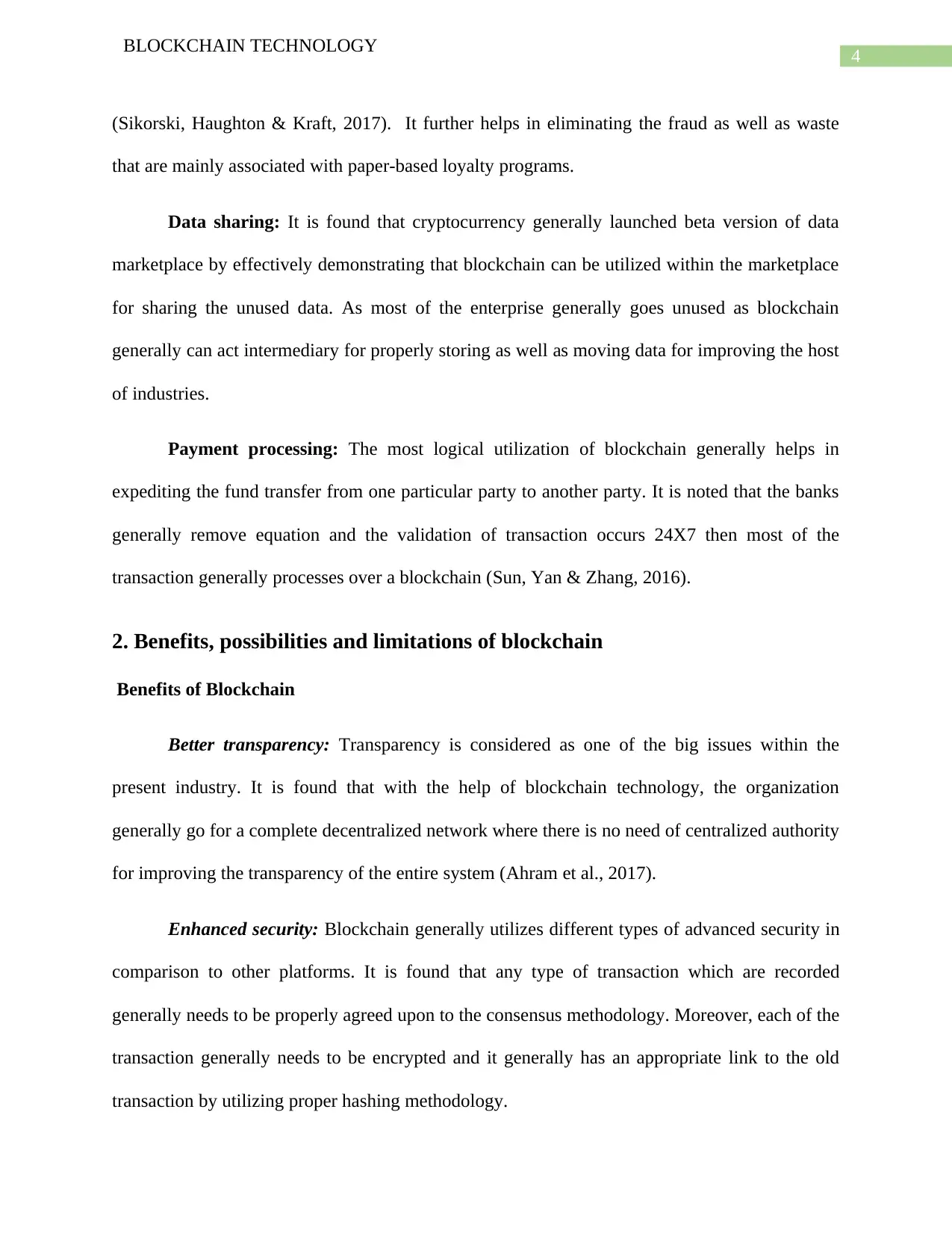
4
BLOCKCHAIN TECHNOLOGY
(Sikorski, Haughton & Kraft, 2017). It further helps in eliminating the fraud as well as waste
that are mainly associated with paper-based loyalty programs.
Data sharing: It is found that cryptocurrency generally launched beta version of data
marketplace by effectively demonstrating that blockchain can be utilized within the marketplace
for sharing the unused data. As most of the enterprise generally goes unused as blockchain
generally can act intermediary for properly storing as well as moving data for improving the host
of industries.
Payment processing: The most logical utilization of blockchain generally helps in
expediting the fund transfer from one particular party to another party. It is noted that the banks
generally remove equation and the validation of transaction occurs 24X7 then most of the
transaction generally processes over a blockchain (Sun, Yan & Zhang, 2016).
2. Benefits, possibilities and limitations of blockchain
Benefits of Blockchain
Better transparency: Transparency is considered as one of the big issues within the
present industry. It is found that with the help of blockchain technology, the organization
generally go for a complete decentralized network where there is no need of centralized authority
for improving the transparency of the entire system (Ahram et al., 2017).
Enhanced security: Blockchain generally utilizes different types of advanced security in
comparison to other platforms. It is found that any type of transaction which are recorded
generally needs to be properly agreed upon to the consensus methodology. Moreover, each of the
transaction generally needs to be encrypted and it generally has an appropriate link to the old
transaction by utilizing proper hashing methodology.
BLOCKCHAIN TECHNOLOGY
(Sikorski, Haughton & Kraft, 2017). It further helps in eliminating the fraud as well as waste
that are mainly associated with paper-based loyalty programs.
Data sharing: It is found that cryptocurrency generally launched beta version of data
marketplace by effectively demonstrating that blockchain can be utilized within the marketplace
for sharing the unused data. As most of the enterprise generally goes unused as blockchain
generally can act intermediary for properly storing as well as moving data for improving the host
of industries.
Payment processing: The most logical utilization of blockchain generally helps in
expediting the fund transfer from one particular party to another party. It is noted that the banks
generally remove equation and the validation of transaction occurs 24X7 then most of the
transaction generally processes over a blockchain (Sun, Yan & Zhang, 2016).
2. Benefits, possibilities and limitations of blockchain
Benefits of Blockchain
Better transparency: Transparency is considered as one of the big issues within the
present industry. It is found that with the help of blockchain technology, the organization
generally go for a complete decentralized network where there is no need of centralized authority
for improving the transparency of the entire system (Ahram et al., 2017).
Enhanced security: Blockchain generally utilizes different types of advanced security in
comparison to other platforms. It is found that any type of transaction which are recorded
generally needs to be properly agreed upon to the consensus methodology. Moreover, each of the
transaction generally needs to be encrypted and it generally has an appropriate link to the old
transaction by utilizing proper hashing methodology.
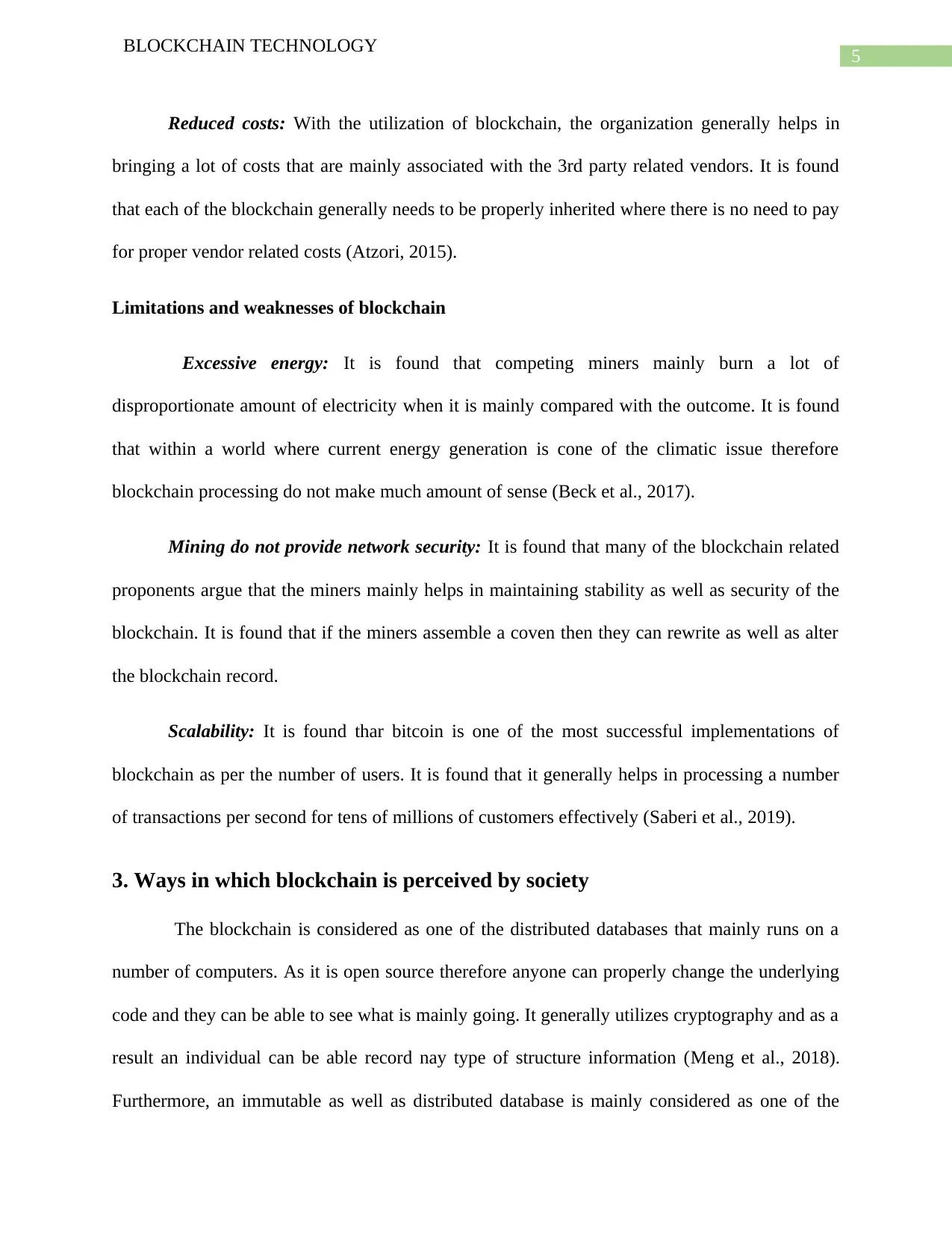
5
BLOCKCHAIN TECHNOLOGY
Reduced costs: With the utilization of blockchain, the organization generally helps in
bringing a lot of costs that are mainly associated with the 3rd party related vendors. It is found
that each of the blockchain generally needs to be properly inherited where there is no need to pay
for proper vendor related costs (Atzori, 2015).
Limitations and weaknesses of blockchain
Excessive energy: It is found that competing miners mainly burn a lot of
disproportionate amount of electricity when it is mainly compared with the outcome. It is found
that within a world where current energy generation is cone of the climatic issue therefore
blockchain processing do not make much amount of sense (Beck et al., 2017).
Mining do not provide network security: It is found that many of the blockchain related
proponents argue that the miners mainly helps in maintaining stability as well as security of the
blockchain. It is found that if the miners assemble a coven then they can rewrite as well as alter
the blockchain record.
Scalability: It is found thar bitcoin is one of the most successful implementations of
blockchain as per the number of users. It is found that it generally helps in processing a number
of transactions per second for tens of millions of customers effectively (Saberi et al., 2019).
3. Ways in which blockchain is perceived by society
The blockchain is considered as one of the distributed databases that mainly runs on a
number of computers. As it is open source therefore anyone can properly change the underlying
code and they can be able to see what is mainly going. It generally utilizes cryptography and as a
result an individual can be able record nay type of structure information (Meng et al., 2018).
Furthermore, an immutable as well as distributed database is mainly considered as one of the
BLOCKCHAIN TECHNOLOGY
Reduced costs: With the utilization of blockchain, the organization generally helps in
bringing a lot of costs that are mainly associated with the 3rd party related vendors. It is found
that each of the blockchain generally needs to be properly inherited where there is no need to pay
for proper vendor related costs (Atzori, 2015).
Limitations and weaknesses of blockchain
Excessive energy: It is found that competing miners mainly burn a lot of
disproportionate amount of electricity when it is mainly compared with the outcome. It is found
that within a world where current energy generation is cone of the climatic issue therefore
blockchain processing do not make much amount of sense (Beck et al., 2017).
Mining do not provide network security: It is found that many of the blockchain related
proponents argue that the miners mainly helps in maintaining stability as well as security of the
blockchain. It is found that if the miners assemble a coven then they can rewrite as well as alter
the blockchain record.
Scalability: It is found thar bitcoin is one of the most successful implementations of
blockchain as per the number of users. It is found that it generally helps in processing a number
of transactions per second for tens of millions of customers effectively (Saberi et al., 2019).
3. Ways in which blockchain is perceived by society
The blockchain is considered as one of the distributed databases that mainly runs on a
number of computers. As it is open source therefore anyone can properly change the underlying
code and they can be able to see what is mainly going. It generally utilizes cryptography and as a
result an individual can be able record nay type of structure information (Meng et al., 2018).
Furthermore, an immutable as well as distributed database is mainly considered as one of the
⊘ This is a preview!⊘
Do you want full access?
Subscribe today to unlock all pages.

Trusted by 1+ million students worldwide
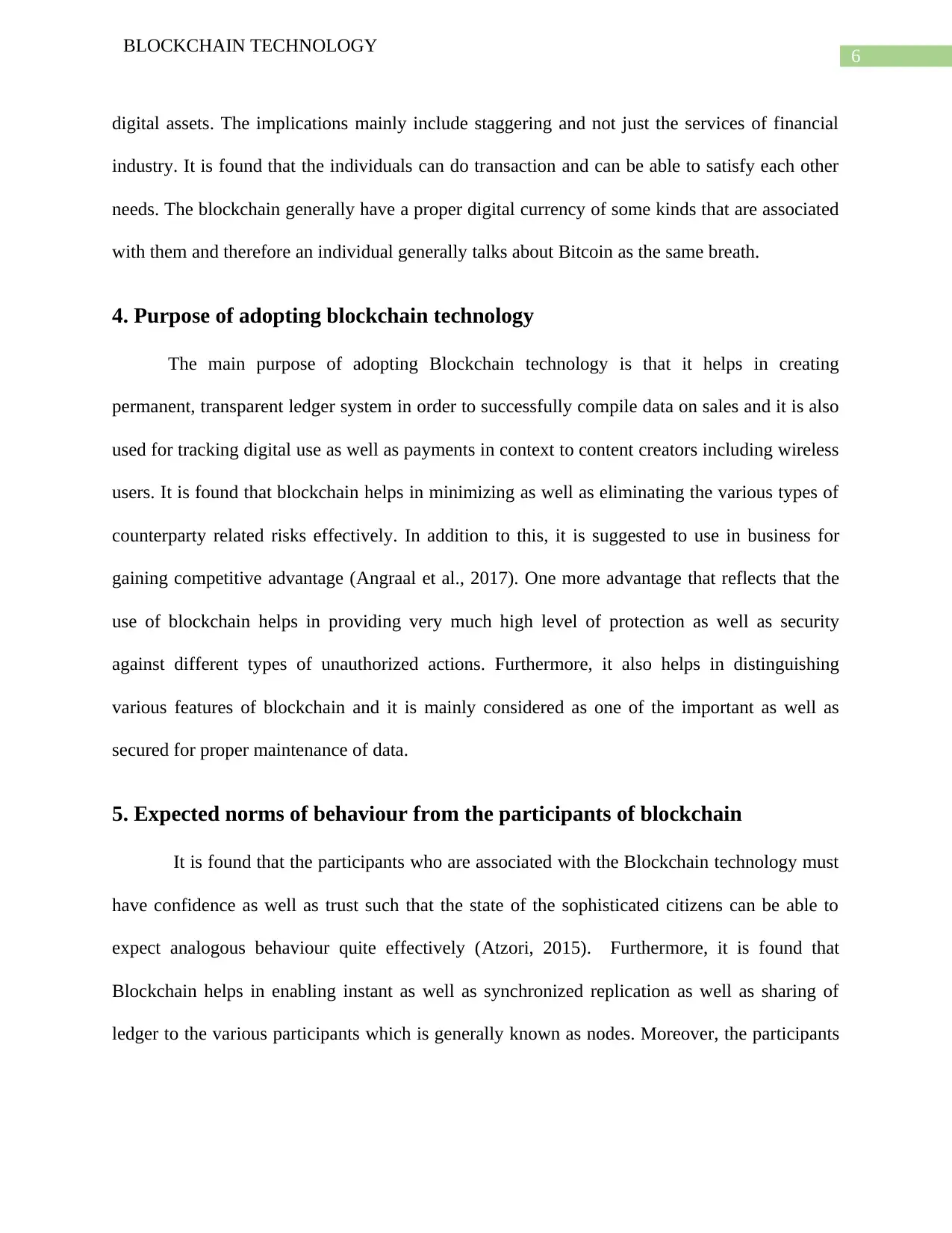
6
BLOCKCHAIN TECHNOLOGY
digital assets. The implications mainly include staggering and not just the services of financial
industry. It is found that the individuals can do transaction and can be able to satisfy each other
needs. The blockchain generally have a proper digital currency of some kinds that are associated
with them and therefore an individual generally talks about Bitcoin as the same breath.
4. Purpose of adopting blockchain technology
The main purpose of adopting Blockchain technology is that it helps in creating
permanent, transparent ledger system in order to successfully compile data on sales and it is also
used for tracking digital use as well as payments in context to content creators including wireless
users. It is found that blockchain helps in minimizing as well as eliminating the various types of
counterparty related risks effectively. In addition to this, it is suggested to use in business for
gaining competitive advantage (Angraal et al., 2017). One more advantage that reflects that the
use of blockchain helps in providing very much high level of protection as well as security
against different types of unauthorized actions. Furthermore, it also helps in distinguishing
various features of blockchain and it is mainly considered as one of the important as well as
secured for proper maintenance of data.
5. Expected norms of behaviour from the participants of blockchain
It is found that the participants who are associated with the Blockchain technology must
have confidence as well as trust such that the state of the sophisticated citizens can be able to
expect analogous behaviour quite effectively (Atzori, 2015). Furthermore, it is found that
Blockchain helps in enabling instant as well as synchronized replication as well as sharing of
ledger to the various participants which is generally known as nodes. Moreover, the participants
BLOCKCHAIN TECHNOLOGY
digital assets. The implications mainly include staggering and not just the services of financial
industry. It is found that the individuals can do transaction and can be able to satisfy each other
needs. The blockchain generally have a proper digital currency of some kinds that are associated
with them and therefore an individual generally talks about Bitcoin as the same breath.
4. Purpose of adopting blockchain technology
The main purpose of adopting Blockchain technology is that it helps in creating
permanent, transparent ledger system in order to successfully compile data on sales and it is also
used for tracking digital use as well as payments in context to content creators including wireless
users. It is found that blockchain helps in minimizing as well as eliminating the various types of
counterparty related risks effectively. In addition to this, it is suggested to use in business for
gaining competitive advantage (Angraal et al., 2017). One more advantage that reflects that the
use of blockchain helps in providing very much high level of protection as well as security
against different types of unauthorized actions. Furthermore, it also helps in distinguishing
various features of blockchain and it is mainly considered as one of the important as well as
secured for proper maintenance of data.
5. Expected norms of behaviour from the participants of blockchain
It is found that the participants who are associated with the Blockchain technology must
have confidence as well as trust such that the state of the sophisticated citizens can be able to
expect analogous behaviour quite effectively (Atzori, 2015). Furthermore, it is found that
Blockchain helps in enabling instant as well as synchronized replication as well as sharing of
ledger to the various participants which is generally known as nodes. Moreover, the participants
Paraphrase This Document
Need a fresh take? Get an instant paraphrase of this document with our AI Paraphraser

7
BLOCKCHAIN TECHNOLOGY
must also follow proper ethical behaviour while handling the blockchain technology quite
effectively.
BLOCKCHAIN TECHNOLOGY
must also follow proper ethical behaviour while handling the blockchain technology quite
effectively.
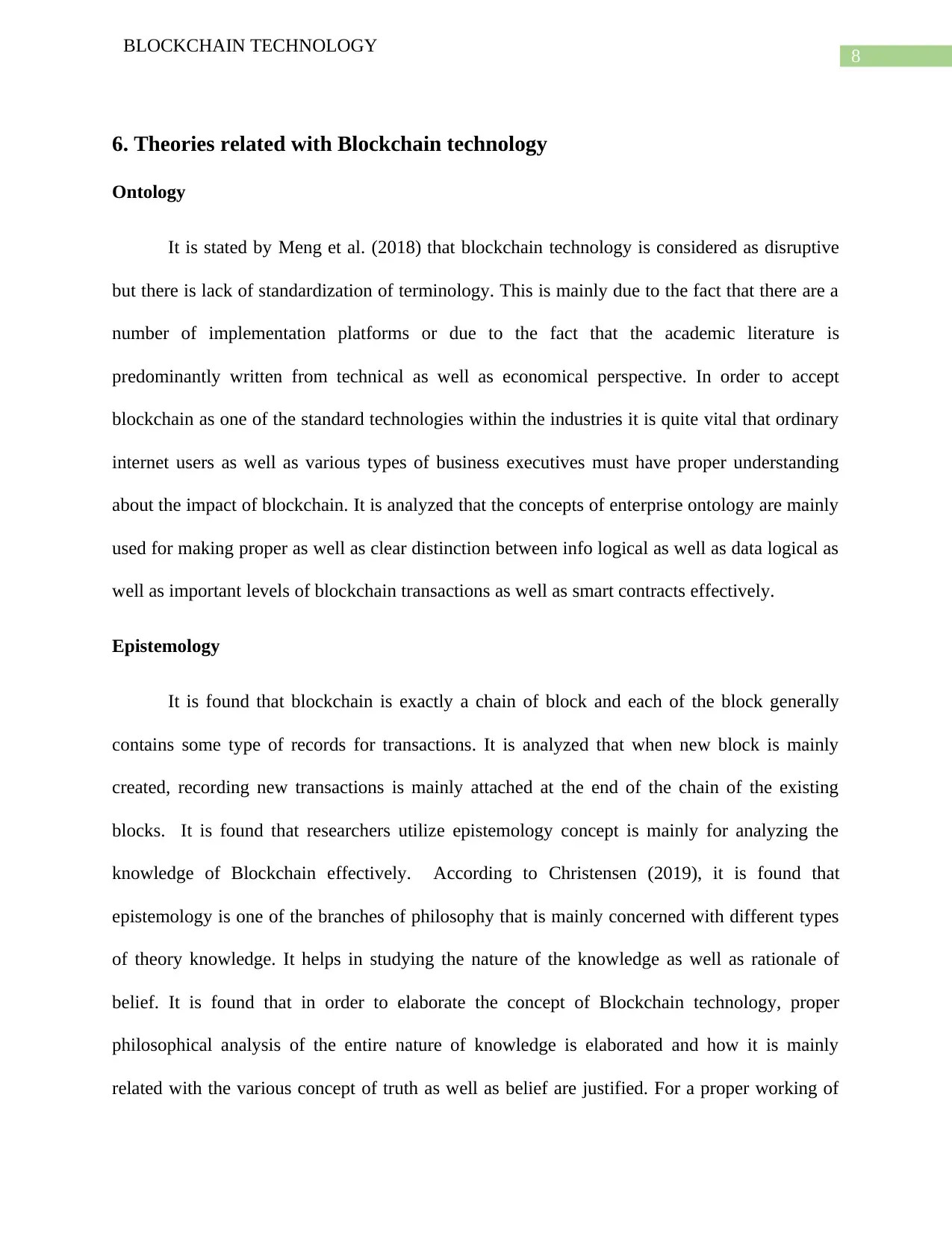
8
BLOCKCHAIN TECHNOLOGY
6. Theories related with Blockchain technology
Ontology
It is stated by Meng et al. (2018) that blockchain technology is considered as disruptive
but there is lack of standardization of terminology. This is mainly due to the fact that there are a
number of implementation platforms or due to the fact that the academic literature is
predominantly written from technical as well as economical perspective. In order to accept
blockchain as one of the standard technologies within the industries it is quite vital that ordinary
internet users as well as various types of business executives must have proper understanding
about the impact of blockchain. It is analyzed that the concepts of enterprise ontology are mainly
used for making proper as well as clear distinction between info logical as well as data logical as
well as important levels of blockchain transactions as well as smart contracts effectively.
Epistemology
It is found that blockchain is exactly a chain of block and each of the block generally
contains some type of records for transactions. It is analyzed that when new block is mainly
created, recording new transactions is mainly attached at the end of the chain of the existing
blocks. It is found that researchers utilize epistemology concept is mainly for analyzing the
knowledge of Blockchain effectively. According to Christensen (2019), it is found that
epistemology is one of the branches of philosophy that is mainly concerned with different types
of theory knowledge. It helps in studying the nature of the knowledge as well as rationale of
belief. It is found that in order to elaborate the concept of Blockchain technology, proper
philosophical analysis of the entire nature of knowledge is elaborated and how it is mainly
related with the various concept of truth as well as belief are justified. For a proper working of
BLOCKCHAIN TECHNOLOGY
6. Theories related with Blockchain technology
Ontology
It is stated by Meng et al. (2018) that blockchain technology is considered as disruptive
but there is lack of standardization of terminology. This is mainly due to the fact that there are a
number of implementation platforms or due to the fact that the academic literature is
predominantly written from technical as well as economical perspective. In order to accept
blockchain as one of the standard technologies within the industries it is quite vital that ordinary
internet users as well as various types of business executives must have proper understanding
about the impact of blockchain. It is analyzed that the concepts of enterprise ontology are mainly
used for making proper as well as clear distinction between info logical as well as data logical as
well as important levels of blockchain transactions as well as smart contracts effectively.
Epistemology
It is found that blockchain is exactly a chain of block and each of the block generally
contains some type of records for transactions. It is analyzed that when new block is mainly
created, recording new transactions is mainly attached at the end of the chain of the existing
blocks. It is found that researchers utilize epistemology concept is mainly for analyzing the
knowledge of Blockchain effectively. According to Christensen (2019), it is found that
epistemology is one of the branches of philosophy that is mainly concerned with different types
of theory knowledge. It helps in studying the nature of the knowledge as well as rationale of
belief. It is found that in order to elaborate the concept of Blockchain technology, proper
philosophical analysis of the entire nature of knowledge is elaborated and how it is mainly
related with the various concept of truth as well as belief are justified. For a proper working of
⊘ This is a preview!⊘
Do you want full access?
Subscribe today to unlock all pages.

Trusted by 1+ million students worldwide
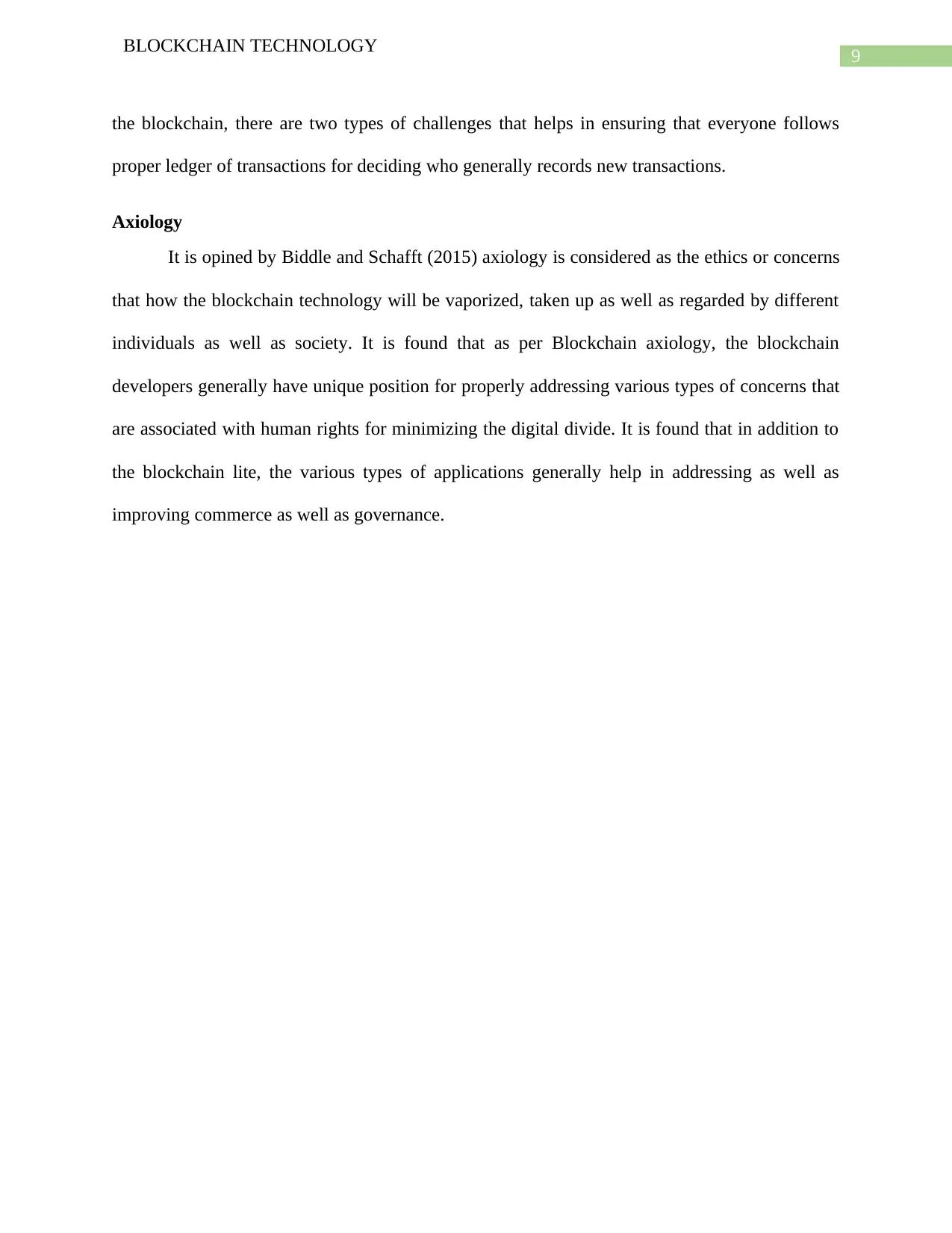
9
BLOCKCHAIN TECHNOLOGY
the blockchain, there are two types of challenges that helps in ensuring that everyone follows
proper ledger of transactions for deciding who generally records new transactions.
Axiology
It is opined by Biddle and Schafft (2015) axiology is considered as the ethics or concerns
that how the blockchain technology will be vaporized, taken up as well as regarded by different
individuals as well as society. It is found that as per Blockchain axiology, the blockchain
developers generally have unique position for properly addressing various types of concerns that
are associated with human rights for minimizing the digital divide. It is found that in addition to
the blockchain lite, the various types of applications generally help in addressing as well as
improving commerce as well as governance.
BLOCKCHAIN TECHNOLOGY
the blockchain, there are two types of challenges that helps in ensuring that everyone follows
proper ledger of transactions for deciding who generally records new transactions.
Axiology
It is opined by Biddle and Schafft (2015) axiology is considered as the ethics or concerns
that how the blockchain technology will be vaporized, taken up as well as regarded by different
individuals as well as society. It is found that as per Blockchain axiology, the blockchain
developers generally have unique position for properly addressing various types of concerns that
are associated with human rights for minimizing the digital divide. It is found that in addition to
the blockchain lite, the various types of applications generally help in addressing as well as
improving commerce as well as governance.
Paraphrase This Document
Need a fresh take? Get an instant paraphrase of this document with our AI Paraphraser
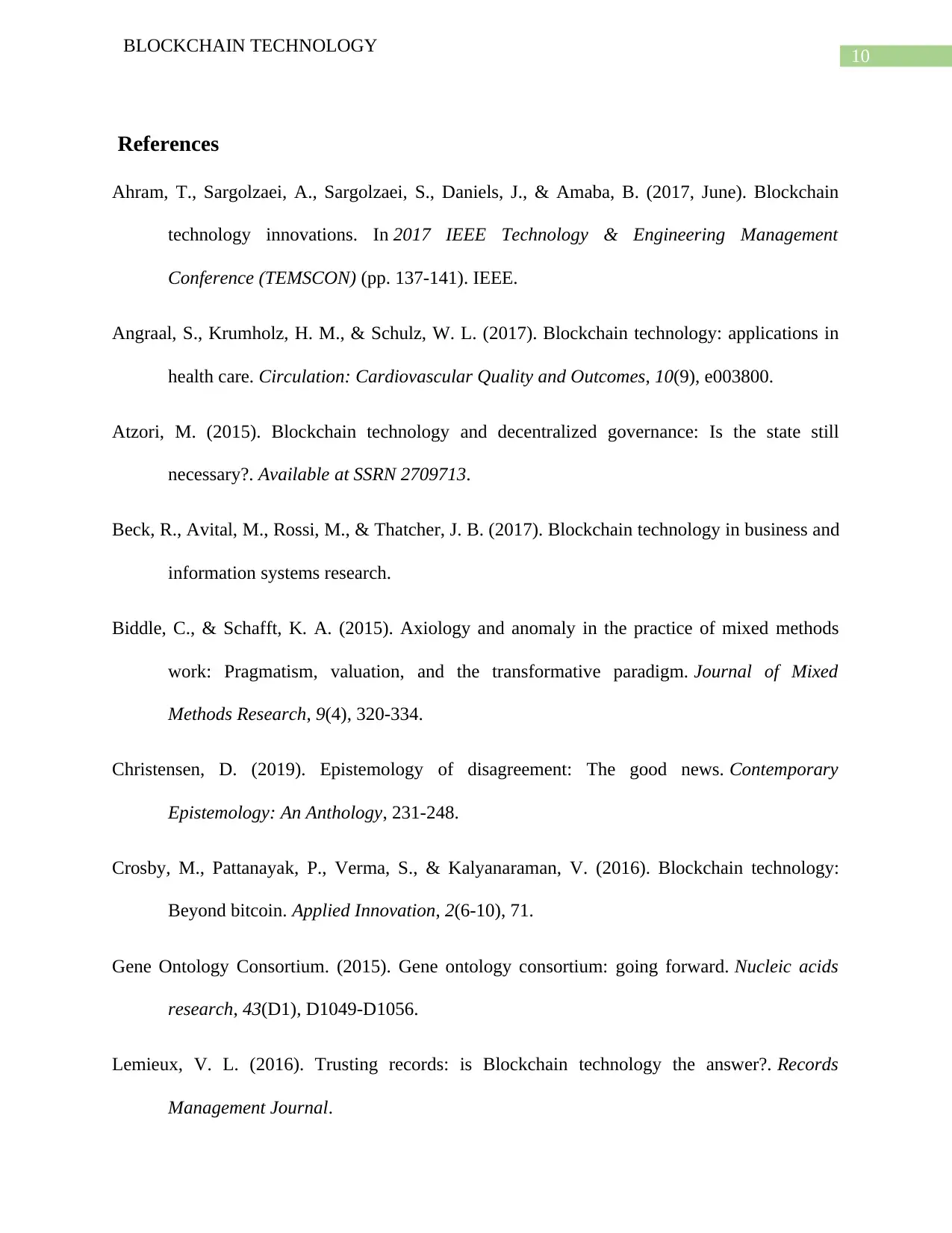
10
BLOCKCHAIN TECHNOLOGY
References
Ahram, T., Sargolzaei, A., Sargolzaei, S., Daniels, J., & Amaba, B. (2017, June). Blockchain
technology innovations. In 2017 IEEE Technology & Engineering Management
Conference (TEMSCON) (pp. 137-141). IEEE.
Angraal, S., Krumholz, H. M., & Schulz, W. L. (2017). Blockchain technology: applications in
health care. Circulation: Cardiovascular Quality and Outcomes, 10(9), e003800.
Atzori, M. (2015). Blockchain technology and decentralized governance: Is the state still
necessary?. Available at SSRN 2709713.
Beck, R., Avital, M., Rossi, M., & Thatcher, J. B. (2017). Blockchain technology in business and
information systems research.
Biddle, C., & Schafft, K. A. (2015). Axiology and anomaly in the practice of mixed methods
work: Pragmatism, valuation, and the transformative paradigm. Journal of Mixed
Methods Research, 9(4), 320-334.
Christensen, D. (2019). Epistemology of disagreement: The good news. Contemporary
Epistemology: An Anthology, 231-248.
Crosby, M., Pattanayak, P., Verma, S., & Kalyanaraman, V. (2016). Blockchain technology:
Beyond bitcoin. Applied Innovation, 2(6-10), 71.
Gene Ontology Consortium. (2015). Gene ontology consortium: going forward. Nucleic acids
research, 43(D1), D1049-D1056.
Lemieux, V. L. (2016). Trusting records: is Blockchain technology the answer?. Records
Management Journal.
BLOCKCHAIN TECHNOLOGY
References
Ahram, T., Sargolzaei, A., Sargolzaei, S., Daniels, J., & Amaba, B. (2017, June). Blockchain
technology innovations. In 2017 IEEE Technology & Engineering Management
Conference (TEMSCON) (pp. 137-141). IEEE.
Angraal, S., Krumholz, H. M., & Schulz, W. L. (2017). Blockchain technology: applications in
health care. Circulation: Cardiovascular Quality and Outcomes, 10(9), e003800.
Atzori, M. (2015). Blockchain technology and decentralized governance: Is the state still
necessary?. Available at SSRN 2709713.
Beck, R., Avital, M., Rossi, M., & Thatcher, J. B. (2017). Blockchain technology in business and
information systems research.
Biddle, C., & Schafft, K. A. (2015). Axiology and anomaly in the practice of mixed methods
work: Pragmatism, valuation, and the transformative paradigm. Journal of Mixed
Methods Research, 9(4), 320-334.
Christensen, D. (2019). Epistemology of disagreement: The good news. Contemporary
Epistemology: An Anthology, 231-248.
Crosby, M., Pattanayak, P., Verma, S., & Kalyanaraman, V. (2016). Blockchain technology:
Beyond bitcoin. Applied Innovation, 2(6-10), 71.
Gene Ontology Consortium. (2015). Gene ontology consortium: going forward. Nucleic acids
research, 43(D1), D1049-D1056.
Lemieux, V. L. (2016). Trusting records: is Blockchain technology the answer?. Records
Management Journal.
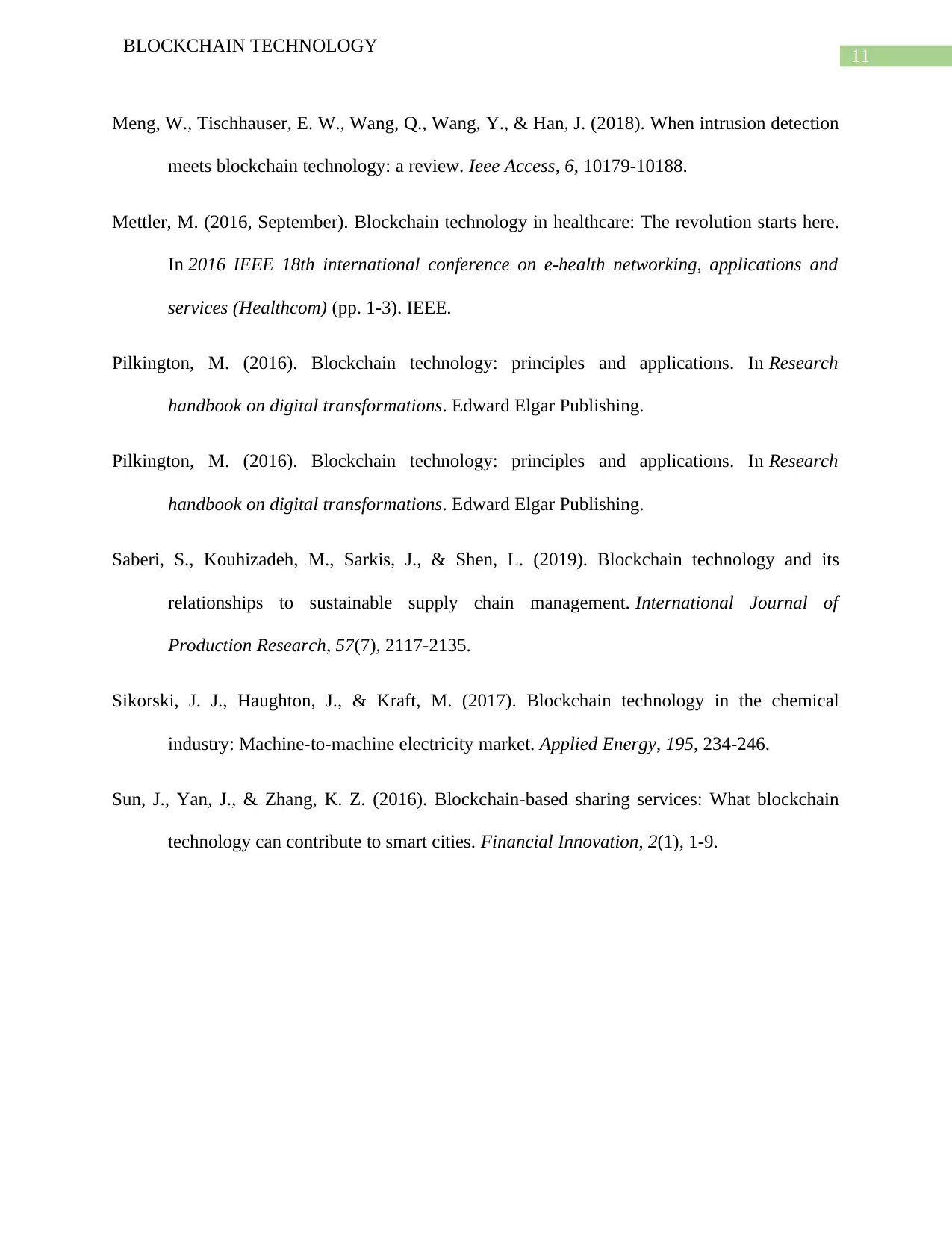
11
BLOCKCHAIN TECHNOLOGY
Meng, W., Tischhauser, E. W., Wang, Q., Wang, Y., & Han, J. (2018). When intrusion detection
meets blockchain technology: a review. Ieee Access, 6, 10179-10188.
Mettler, M. (2016, September). Blockchain technology in healthcare: The revolution starts here.
In 2016 IEEE 18th international conference on e-health networking, applications and
services (Healthcom) (pp. 1-3). IEEE.
Pilkington, M. (2016). Blockchain technology: principles and applications. In Research
handbook on digital transformations. Edward Elgar Publishing.
Pilkington, M. (2016). Blockchain technology: principles and applications. In Research
handbook on digital transformations. Edward Elgar Publishing.
Saberi, S., Kouhizadeh, M., Sarkis, J., & Shen, L. (2019). Blockchain technology and its
relationships to sustainable supply chain management. International Journal of
Production Research, 57(7), 2117-2135.
Sikorski, J. J., Haughton, J., & Kraft, M. (2017). Blockchain technology in the chemical
industry: Machine-to-machine electricity market. Applied Energy, 195, 234-246.
Sun, J., Yan, J., & Zhang, K. Z. (2016). Blockchain-based sharing services: What blockchain
technology can contribute to smart cities. Financial Innovation, 2(1), 1-9.
BLOCKCHAIN TECHNOLOGY
Meng, W., Tischhauser, E. W., Wang, Q., Wang, Y., & Han, J. (2018). When intrusion detection
meets blockchain technology: a review. Ieee Access, 6, 10179-10188.
Mettler, M. (2016, September). Blockchain technology in healthcare: The revolution starts here.
In 2016 IEEE 18th international conference on e-health networking, applications and
services (Healthcom) (pp. 1-3). IEEE.
Pilkington, M. (2016). Blockchain technology: principles and applications. In Research
handbook on digital transformations. Edward Elgar Publishing.
Pilkington, M. (2016). Blockchain technology: principles and applications. In Research
handbook on digital transformations. Edward Elgar Publishing.
Saberi, S., Kouhizadeh, M., Sarkis, J., & Shen, L. (2019). Blockchain technology and its
relationships to sustainable supply chain management. International Journal of
Production Research, 57(7), 2117-2135.
Sikorski, J. J., Haughton, J., & Kraft, M. (2017). Blockchain technology in the chemical
industry: Machine-to-machine electricity market. Applied Energy, 195, 234-246.
Sun, J., Yan, J., & Zhang, K. Z. (2016). Blockchain-based sharing services: What blockchain
technology can contribute to smart cities. Financial Innovation, 2(1), 1-9.
⊘ This is a preview!⊘
Do you want full access?
Subscribe today to unlock all pages.

Trusted by 1+ million students worldwide
1 out of 12
Related Documents
Your All-in-One AI-Powered Toolkit for Academic Success.
+13062052269
info@desklib.com
Available 24*7 on WhatsApp / Email
![[object Object]](/_next/static/media/star-bottom.7253800d.svg)
Unlock your academic potential
Copyright © 2020–2025 A2Z Services. All Rights Reserved. Developed and managed by ZUCOL.




